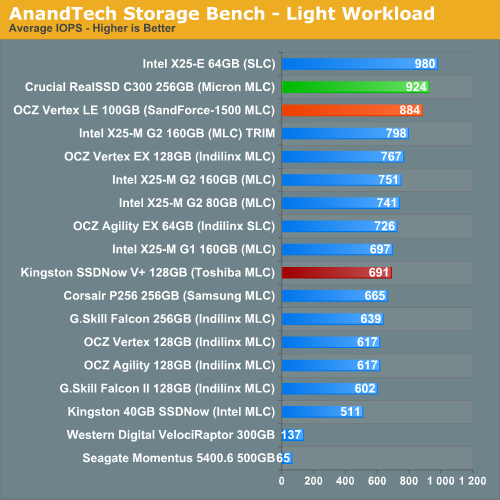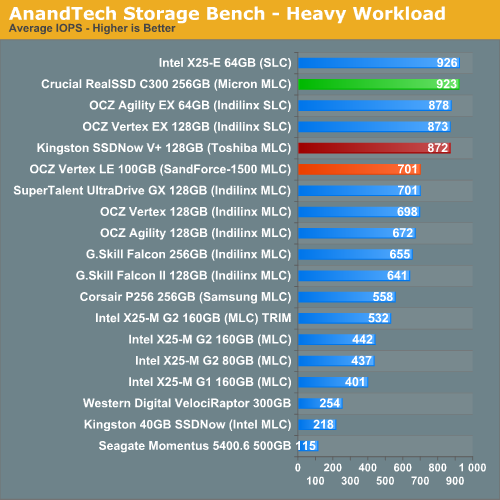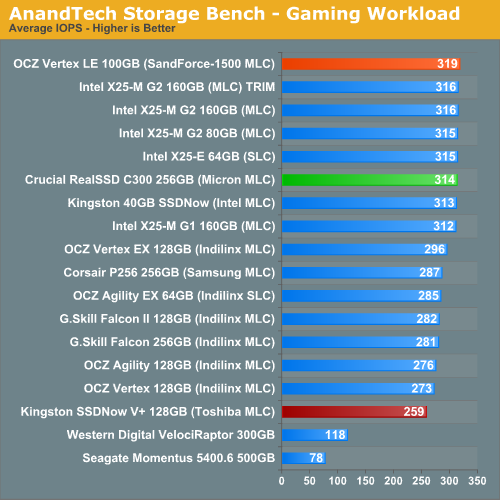OCZ’s Vertex Limited Edition Review & SSD State of the Union
by Anand Lal Shimpi on February 19, 2010 12:00 AM EST- Posted in
- Storage
AnandTech Storage Bench
Note that our 6Gbps controller driver isn't supported by our custom storage bench here, so the C300 results are only offered in 3Gbps mode.
The first in our benchmark suite is a light usage case. The Windows 7 system is loaded with Firefox, Office 2007 and Adobe Reader among other applications. With Firefox we browse web pages like Facebook, AnandTech, Digg and other sites. Outlook is also running and we use it to check emails, create and send a message with a PDF attachment. Adobe Reader is used to view some PDFs. Excel 2007 is used to create a spreadsheet, graphs and save the document. The same goes for Word 2007. We open and step through a presentation in PowerPoint 2007 received as an email attachment before saving it to the desktop. Finally we watch a bit of a Firefly episode in Windows Media Player 11.
There’s some level of multitasking going on here but it’s not unreasonable by any means. Generally the application tasks proceed linearly, with the exception of things like web browsing which may happen in between one of the other tasks.
The recording is played back on all of our drives here today. Remember that we’re isolating disk performance, all we’re doing is playing back every single disk access that happened in that ~5 minute period of usage. The light workload is composed of 37,501 reads and 20,268 writes. Over 30% of the IOs are 4KB, 11% are 16KB, 22% are 32KB and approximately 13% are 64KB in size. Less than 30% of the operations are absolutely sequential in nature. Average queue depth is 6.09 IOs.
The performance results are reported in average I/O Operations per Second (IOPS):

Under a typical, light poweruser workload, the Crucial RealSSD C300 bests OCZ's Vertex LE by 4.5% - not a tangible difference, just a (barely) measurable one. Intel's SLC X25-E is actually still the fastest thing here, which must be frustrating for Intel since the only thing separating the G2s from topping the charts is sequential write speed.
The Toshiba based Kingston drive performs similarly to the MLC based Indilinx drives, which is good since that's exactly where it's supposed to perform.
If there’s a light usage case there’s bound to be a heavy one. In this test we have Microsoft Security Essentials running in the background with real time virus scanning enabled. We also perform a quick scan in the middle of the test. Firefox, Outlook, Excel, Word and Powerpoint are all used the same as they were in the light test. We add Photoshop CS4 to the mix, opening a bunch of 12MP images, editing them, then saving them as highly compressed JPGs for web publishing. Windows 7’s picture viewer is used to view a bunch of pictures on the hard drive. We use 7-zip to create and extract .7z archives. Downloading is also prominently featured in our heavy test; we download large files from the Internet during portions of the benchmark, as well as use uTorrent to grab a couple of torrents. Some of the applications in use are installed during the benchmark, Windows updates are also installed. Towards the end of the test we launch World of Warcraft, play for a few minutes, then delete the folder. This test also takes into account all of the disk accesses that happen while the OS is booting.
The benchmark is 22 minutes long and it consists of 128,895 read operations and 72,411 write operations. Roughly 44% of all IOs were sequential. Approximately 30% of all accesses were 4KB in size, 12% were 16KB in size, 14% were 32KB and 20% were 64KB. Average queue depth was 3.59.

I ran and re-ran the tests - they're accurate. The Vertex LE does well, just not as good as the Kingston or Crucial drives here. The Crucial RealSSD C300 is simply a beast in our write-heavy test. I suspect that the fact that many of our writes here are compressed is to blame for the Vertex LE not being as fast as usual here. Remember that SandForce's architecture works by data reduction, whether through compression, deduplication or other similar natured algorithm. By definition those algorithms don't work well on data that is already being written in reduced form. If you're dealing with a lot of compressed archives, the Vertex LE will perform well, but not as well as the RealSSD C300.
Our final test focuses on actual gameplay in four 3D games: World of Warcraft, Batman: Arkham Asylum, FarCry 2 and Risen, in that order. The games are launched and played, altogether for a total of just under 30 minutes. The benchmark measures game load time, level load time, disk accesses from save games and normal data streaming during gameplay.
The gaming workload is made up of 75,206 read operations and only 4,592 write operations. Only 20% of the accesses are 4KB in size, nearly 40% are 64KB and 20% are 32KB. A whopping 69% of the IOs are sequential, meaning this is predominantly a sequential read benchmark. The average queue depth is 7.76 IOs.

Just as we saw with our PCMark tests, all of the drives perform about the same here. If you're just going to be tossing games on your SSD, you can't really go wrong with any of these drives. It's possible that if we were able to use our 6Gbps controller here that Crucial would break the mold as the drives here appear to be limited by sequential read speed.










83 Comments
View All Comments
mertl - Thursday, March 18, 2010 - link
The Sandforce Controller has hardware AES encryption, which could be used with OCZ Toolbox (which is not available).It's a self encrypting drive. No CPU Performance wasted with software encryption.
Why doesn't the Vertex LE support FDE (TCG OPAL Standard like a Seagate Momentus 7200 FDE.4)? The BIOS ATA PWD is passed to the drive, alternatively Pre-Boot Utilities like wave can be used.
jaggerwild - Saturday, March 13, 2010 - link
It's kinda sad that they will not at least replace the drive with an equal value SSD, I suggest to anybody considering buying any OCZ product to read through there forum before making a purchase!!! People are reporting waiting seven months for warranties on the Vertex series? Today more than ever people are not getting what they paid for and to even post a review of there product is a slap in our collective faces. But I guess Aandtech is selling out too as they have there advertisement up top of this section LOL!NandFlashGuy - Friday, March 12, 2010 - link
Hi Anand,I think your characterization of all IMFT flash as equivalent creates a false idea of quailty equilvalence for readers.
"It’s uses a standard Indilinx Barefoot controller but is paired with IMFT 34nm flash branded either as Intel or Micron. It’s the same flash that’s used in the X25-M G2s."
Intel does not sell enterprise-grade or SSD Nand to competitors. It does do more testing on the Nand used inside the X-25M G2s, ensuring it meets a higher quality level.
While nothing prevents SSD competitors from buying USB-key grade Nand and using it their SSDs, it's incorrect to call it the same Nand that Intel uses.
ayembee - Sunday, March 7, 2010 - link
Well, my 200GB LE lasted one week -- picked it up last Sunday, and now it's so dead the BIOS can no longer even find it. That's one seriously expensive paperweight...deBlanc - Friday, March 5, 2010 - link
Has anyone tried a Raid 1 (mirror) with an SSD and an HDD? I have a customer with a Dell R410 server which has very limited expansion capabilites, only one expansion slot which has a 4 port NIC in it. They are starting to run into disk I/O issues. Short of buying a new server, I was thinking of Raiding a 500 GB OCZ Colossus with a 500 GB Seagate 7200.12, the idea being much faster reads with failover to the HDD if the SSD bricks. I can't afford to buy the SSD to test this out. What do you experts say?Thanks
db
SeanFowler - Friday, February 26, 2010 - link
Overclockers UK has confirmed with Crucial that the 128GB version of the drive has a far slower write speed. They've been told that the write speed is up to 140MB/s.The details are on page 1 here: http://download.micron.com/pdf/datasheets/realssd/...">http://download.micron.com/pdf/datasheets/realssd/...
Compare this to 235MB/s sustained write on the LE, and 250MB/s max write, and there's no competition.
Yes the C300 still has amazing read speeds, but I think the LE is the better all-round performer.
Unless we find out that the numbers we've been seeing on the net for the LE are for the 256GB version and have been erroneously attributed to the 128GB version as well.
I had the LE on order, then cancelled it to order the C300, then found out that the 128GB drive has mediocre write speeds. Talk about a mess!
Beno - Thursday, February 25, 2010 - link
in Final Words, first paragraph, fifth line.Crucla
bizautomation - Wednesday, February 24, 2010 - link
I contacted the folks at SandForce for a comment on the un-ceremonious death of the OCZ test drive. Below is my question to them, and their response:My email to SandForce:
Dear SandForce,
This is more for the blog community, than it is for me personally (although I am considering Enterprise SSDs for our database servers). I don't think it warrants your phone time. If you can simply prepare a statement in reaction to the test drive going bellly up at Anantech's test center, which I can post, I think that would be more than enough.
Here's the main concern out there:
1. CTO's like me are seriously looking at these drives to consider putting their databases on (SaaS based applications can benefit from the performance improvements).
2. We are deathly afraid of the reliability issues, so when initial articles about SandForce controllers came out with the emphasis on reliability, everyone was cautiosly elated.
3. We see a follow-up story on Anantech (arguably THE source of impartial news on hardware), show that the OCZ drive just "died", and I think it's safe to say, there's significant concern.
Yes, everyone knows it was a pre-production drive (Anantech makes that clear), but the cat is now out of the bag, and without a proper forensic investigation, I'm concerned this would happen witth a production drive. Hence my reaching out to
your firm for an explenation beyond "Oh don't worry guys, that was pre-production hardware". As you know, our community is comprised of smart people, and that type of answer just doesn't cut it.
What say you ?
Their answer to me:
Dear Carl,
We appreciate the inquiry and definitely appreciate your concern. It was appropriate that Anandtech highlight the drive that failed was a pre-production drive. The drive used Beta firmware, which by definition, had known issues.
Since then, SandForce has released its ‘release candidate’ firmware to our customer base of SSD vendors with the intent for them to run their qualification process on the drives and intensive tests for stability. We have received positive feedback so far. We’ll take any issues that we hear of (and any that we find ourselves) and release a ‘mass production’ version of firmware with the intent for end user customer shipments and usage. We’re confident that with the large number of leading SSD vendors in both Enterprise and Client markets that are qualifying drives based on our silicon and FW, in addition to our own robust testing capabilities, production drives based on SandForce will be of the highest reliability.
anuraaga - Wednesday, February 24, 2010 - link
Looking at a Japanese retailer's listing for the RealSSD drives at http://bit.ly/clxvoa">http://bit.ly/clxvoa, the write speeds of the 128GB and 256GB versions differ by around 50%!Random 4K Write:
128GB - 140 MB/s, 30K IOPS
256GB - 215 MB/s, 45K IOPS
Out of curiosity, which version was tested in this article? The numbers are close to the listed 128GB specs, so that's what I'm guessing. What could result in such a big difference in write performance in this as well as other drives(DRAM size?)? Or is this just some retailer manipulating the numbers to sell a more expensive part (work in research long enough and you get to know the amazing things possible through the use of normalization)...
eldiablopotato - Tuesday, February 23, 2010 - link
Don't suppose C300 vs. Vertex LE review is around the corner?